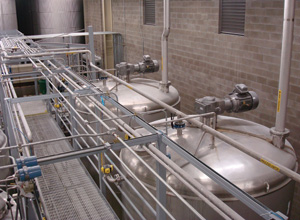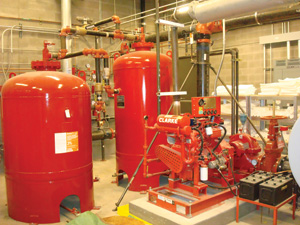Chemical Safety Matters



November 17, 2010
BY Bryan Sims
Producing biodiesel is a relatively easy and straightforward process, but handling and containing the various hazardous chemicals it involves should not be taken lightly. Common chemicals found at a plant, such as methanol, can leave plants vulnerable to fires and explosions if the equipment isn't properly designed within state, local and municipal fire codes. Additionally, plant personnel are expected and required to go through extensive chemical spill and fire response training in order to help preserve property, and personnel safety, in accordance to Occupational Safety and Health Administration and International Fire Code standards, along with other supporting local or state safety protocols.
Despite the industry's good-faith efforts for enforcing chemical safety practices, its track record can tell a different story. From 2006 until 2009, approximately 21 accidents occurred in the form of fires or explosions, according to information reported in Biodiesel Magazine. Of that total, nearly half were linked to improper handling or containment of hazardous chemicals.
"In municipalities where these plants were going in, it was a new thing for them," says Will Smith, engineering manager for Salem, Ore.-based Pacific Biodiesel Technologies Inc. Since 2000, PBT has provided engineering, equipment, contracting and laboratory services for 10 biodiesel plants in the U.S. "Fire marshals and permitting officials leaned heavily on owners and, through negligence, there was a lot of confusion on how to interpret the codes at that time," Smith continues. "Some fire code consultants didn't know how to classify, for example, a mixture and a reactor."
As recently as July, Innovation Fuels Inc.'s 40 MMgy plant in Newark, N.J., had an explosion that injured an employee. The cause was attributed to a sulfuric acid leak from inside the plant's containment area. The employee was connecting hoses to a tanker truck filled with methanol when the sulfuric acid container behind him leaked and subsequently burst.
In an industry that relied heavily on a tax credit during its heady days of breakneck growth, the incentive has since expired, causing many plants to curtail installed capacity or shut down operations altogether. Consequently, concerns mount whether operating plants, including those in "hot idle" status, have the financial resources available to put chemical safety at the top of their lists as the industry heads into 2011. Regardless of financial standing, according to Smith and fire department officials, producers should keep chemical safety a high priority during both the preconstruction and operation phases.
Building to Code
As the saying goes, "compliance costs money." But the cost to upgrade fire- or explosion-damaged property will by far outweigh the cost of installing fire protection equipment carefully selected during the engineering and permitting stage. Typically, biodiesel plants adhere to National Fire Protection Association code 30, which is a common starting point for engineers in preconstruction and for local fire authorities for compliance during inspections when built. The code outlines specific containment and spatial procedures for flammable and combustible liquids stored in a facility.
NFPA 30 gives specified classification ratings to various chemicals according to their flammability and combustibility properties. For example, biodiesel and glycerin have a flash point at or above 200 degrees Fahrenheit and are listed as Class IIIB combustible liquids. Methanol is a Class IB flammable liquid and sodium methoxide is a Class IC flammable liquid. Sulfuric acid and sodium hydroxide (lye) are nonflammable and noncombustible, but are very reactive caustic materials.
One of the best ways for plants to mitigate risks of potential fires or explosions is to involve local fire authorities early on in the design of the plant to ensure that proper fire protection systems are in place in the event a fire or explosion occurs, according to Jason Allen, fire safety engineer for the Georgia State Fire Marshal's Office. "One of the best things that people can do is to make sure they get with their local fire authorities, whether it's the fire department or the fire prevention bureau within the fire department," he says. "Meet up with them, go over emergency planning, bring the fire department in and go over with them where hazardous materials are."
The additional cost of proper engineering and equipment will pay off, especially in the face of human error, Smith says. He agrees with Allen that plants should maintain a solid rapport with local fire authorities particularly whenever plants choose to make modifications. "Whenever we make a major change at a plant, we like to bring them out to show them," Smith says. "If you move tanks or change contents of tanks and so forth and if there was ever an accident, first responders may be unfamiliar with what's being installed."
Plants should also consider staying in line with what National Electric Code requirements call for when developing a project or while in operation, according to Allen. Certain code requirements, he says, target specific placement and usage for C-lofts, explosion-proof boxes/junctions and so on. Specific codes within the NEC also warrant procedures for grounding and bonding electrical wiring when plants are exposed to nonconductive flammable liquids that have the potential to build up a surface charge to static electricity. "You want to have certain ground procedures where you can help alleviate static build-up to ground or have bonding where you have electrical continuity," Allen says. "This is especially true if you're going through polymeric or elastomeric type hoses so you can maintain some sort of electrical continuity there."
Knowledge is Power
The prevailing consensus among biodiesel producers, according to Sanjeev Saraf, a senior associate with Exponent Inc. and author of the Risk and Safety Blog, is that process safety can be achieved by common sense and enforcement of prescriptive codes and standards; however, considerable expertise is needed to comprehensively mitigate biodiesel manufacturing risks. One of the best ways to ensure chemical safety is to voluntarily adopt a process safety management (PSM) program. The code of federal regulations 29 under CFR 1910.119 mandates a PSM program if more than 10,000 pounds (1,517 gallons) of methanol is present in a production facility, and all but the smallest of plants have more than this amount. Implementing a PSM can not only assist the biodiesel industry in the prevention of catastrophic accidents, but it can also enhance employee knowledge of operations, improve technical procedures, maintain accurate process safety information and increase overall facility productivity.
At first glance the documentation requirements of a PSM may seem daunting, but a guideline document to ensure compliance with a PSM without consuming too many resources can be developed, according to Smith.
"You can never build anything that's 'idiot proof,' especially when you're handling flammable and combustible liquids," he says. Clearly, being in compliance with construction codes goes hand-in-hand with compliance of personnel safety training codes. "It's very important for everybody to be informed," Smith adds. "Even at smaller facilities under those 10,000 pounds, it's still a good idea to implement a PSM-type program anyway. It may be more of a burden at a smaller plant, but the hazards remain the same to personnel."
The PSM program is not a document that can be copied from one site and applied to another. Each phase of the operation is evaluated for potential hazards and problems that could be encountered during normal operation, start-up, shut down and standby or down time.
A fundamental starting point, Allen says, is for plant personnel to regularly refer to their Materials Safety Data Sheet, a thick booklet found at every chemical plant as required by OSHA. The MSDS describes in detail the chemical characteristics and properties of each hazardous chemical staff are exposed to, along with recommended safety response measures in the event an accident occurs.
"Although some of the chemicals may be nonflammable and noncombustible, they can certainly go through reactions that create flammable gases and heat; in some cases enough heat to self-ignite," Allen says. "It's best to always know the reactions that you're using as well as recognize hypothetical reactions that could occur if the wrong chemicals-or steps-are mixed together."
Author: Bryan Sims
Associate Editor, Biodiesel Magazine
(701) 738-4974
bsims@bbiinternational.com
Advertisement
Advertisement
Upcoming Events





